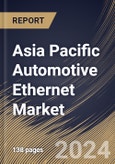Several trends are shaping the trajectory of the market, reflecting the dynamic nature of the automotive industry and its technological advancements. As real-time communication becomes critical for applications like autonomous driving and advanced safety systems, the integration of Time-Sensitive Networking (TSN) into automotive Ethernet is gaining prominence. Due to its deterministic latency, TSN is well-suited for timing-sensitive applications, such as coordinating the operations of multiple vehicle components.
Furthermore, the shift towards Ethernet is influencing the overall in-vehicle networking architecture. Traditional bus systems give way to Ethernet-based communication, leading to the development of service-oriented architectures. This shift enables better scalability, flexibility, and integration for complex automotive systems. The integration of Ethernet into in-vehicle communication is catalyzing the development of service-oriented architectures (SOA). Unlike traditional monolithic architectures, SOA breaks down the various functionalities within a vehicle into modular and independent services. Each service operates as a self-contained unit, communicating with others through standardized interfaces facilitated by Ethernet.
India's automotive landscape is witnessing a significant surge in the demand for connected vehicles. Consumers increasingly seek cars equipped with advanced connectivity features, driving the adoption of in-vehicle communication technologies. This, owing to its exceptional data transmission speeds, emerges as a pivotal facilitator in integrating connected vehicle solutions, thereby catering to the changing demands of Indian consumers. As per the data by the India Brand Equity Foundation, automobile production in India totaled 22.93 million units in FY22. The Indian sector is robust with regard to both domestic demand and exports. The total number of passenger vehicles sold in FY23 was 3.89 million. The aggregate value of automobile exports from India in FY23 was $47.51,487. Therefore, with the growing automotive sector in Asia Pacific, there will be increased demand for this Ethernet in the region.
The China market dominated the Asia Pacific Automotive Ethernet Market by Country in 2022, and would continue to be a dominant market till 2030; thereby, achieving a market value of $631.3 million by 2030. The Japan market is registering a CAGR of 14% during (2023 - 2030). Additionally, The India market would showcase a CAGR of 15.4% during (2023 - 2030).
Based on Vehicle Type, the market is segmented into Passenger Cars, and Commercial Vehicles. Based on Component, the market is segmented into Hardware, Software, and Services. Based on Application, the market is segmented into Driver Assistance, Infotainment, Powertrain, Chassis, Body and Comfort, and Others. Based on countries, the market is segmented into China, Japan, India, South Korea, Singapore, Malaysia, and Rest of Asia Pacific.
List of Key Companies Profiled
- Broadcom, Inc.
- NXP Semiconductors N.V.
- Marvell Technology Group Ltd.
- Microchip Technology Incorporated
- Vector Informatik GmbH
- Molex, LLC (Koch Industries, Inc.)
- Texas Instruments, Inc.
- Cadence Design Systems, Inc.
- Keysight Technologies, Inc.
- Aukua Systems Inc.
Market Report Segmentation
By Vehicle Type- Passenger Cars
- Commercial Vehicles
- Hardware
- Software
- Services
- Driver Assistance
- Infotainment
- Powertrain
- Chassis
- Body and Comfort
- Others
- China
- Japan
- India
- South Korea
- Singapore
- Malaysia
- Rest of Asia Pacific
Table of Contents
Companies Mentioned
- Broadcom, Inc.
- NXP Semiconductors N.V.
- Marvell Technology Group Ltd.
- Microchip Technology Incorporated
- Vector Informatik GmbH
- Molex, LLC (Koch Industries, Inc.)
- Texas Instruments, Inc.
- Cadence Design Systems, Inc.
- Keysight Technologies, Inc.
- Aukua Systems Inc.
Methodology

LOADING...








